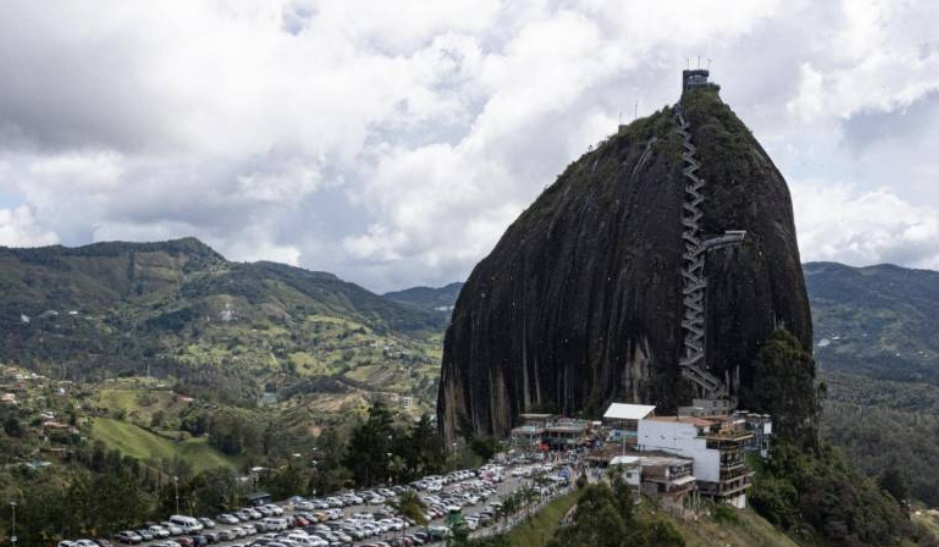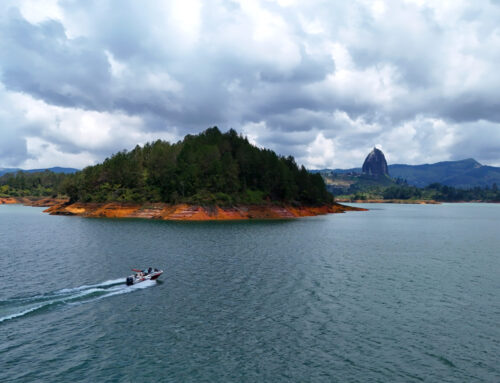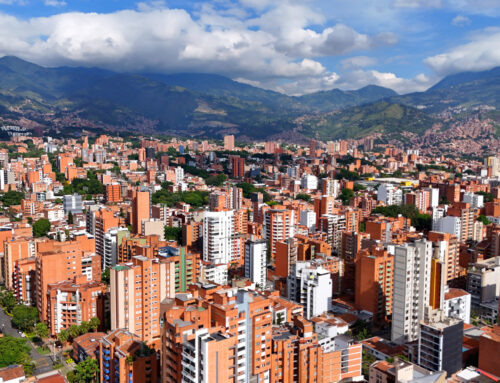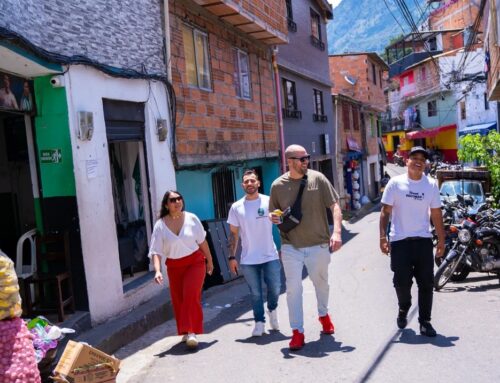La Piedra del Peñol, a monolithic rock formation towering over the picturesque town of Guatapé in Colombia, is a geological wonder that captivates visitors with its sheer size and unique appearance. Rising to a height of 755 feet (230 meters), this massive monolith is a testament to the incredible forces that have shaped the Earth over millions of years.
A Geological Titan in the Heart of Antioquia
Nestled in the heart of the Antioquia department, La Piedra del Peñol is a prominent landmark that has become synonymous with the region. Its distinctive shape, resembling a giant teardrop, is the result of a complex interplay of geological processes that have sculpted the landscape over millennia.
The rock is believed to have formed during the Precambrian era, approximately 4.6 billion to 541 million years ago. During this time, intense volcanic activity and tectonic plate movements created the conditions for the formation of granite, the primary rock type that constitutes La Piedra del Peñol. Over millions of years, erosion and weathering gradually exposed the monolith, revealing its impressive size and unique shape.
The surrounding area is also rich in geological features, including the nearby Guatapé Reservoir, which was formed by the construction of a dam in the early 20th century. The reservoir has created a beautiful lake surrounded by rolling hills and lush vegetation, providing a stunning backdrop for visitors exploring the region.
The Formation of a Geological Marvel
The formation of La Piedra del Peñol is a fascinating story of erosion, weathering, and the passage of time. Originally part of a larger rock formation, the monolith was gradually exposed through the relentless forces of nature. Wind, rain, and temperature fluctuations chipped away at the surrounding rock, leaving behind this impressive remnant.
Over millions of years, the forces of erosion and weathering have continued to shape the appearance of La Piedra del Peñol. The rock’s surface is marked by a network of cracks and fissures, evidence of the intense geological forces that have acted upon it. These features contribute to the rock’s unique texture and character.
In addition to erosion and weathering, tectonic activity has also played a role in shaping the landscape around La Piedra del Peñol. The region is located near a fault zone, where the Earth’s tectonic plates meet and interact. Earthquakes and other seismic events may have contributed to the formation of the monolith and the surrounding geological features.
A Granite Colossus
La Piedra del Peñol is primarily composed of granite, a hard, igneous rock formed deep beneath the Earth’s surface. This sturdy material has contributed to the rock’s remarkable durability, allowing it to withstand the test of time and the elements.
Granite is a coarse-grained rock that is typically composed of quartz, feldspar, and mica. These minerals give granite its characteristic speckled appearance. The specific composition of La Piedra del Peñol’s granite may vary slightly due to the geological conditions that existed during its formation.
The hardness and durability of granite have made it a valuable building material for centuries. Many famous structures, such as the Egyptian pyramids and the Taj Mahal, are constructed from granite. The monolith’s resistance to erosion and weathering is a testament to the strength and durability of this remarkable rock.
A Staircase to the Summit
To reach the summit of La Piedra del Peñol, visitors must climb a series of 740 steps carved into the side of the rock. The ascent is a challenging but rewarding experience, offering breathtaking panoramic views of the surrounding countryside.
The steps were constructed in the early 20th century to allow visitors to climb to the top of the monolith. The ascent is a gradual climb, with several resting areas along the way. The journey to the summit is rewarded with stunning views of the town of Guatapé, the Guatapé Reservoir, and the surrounding mountains.
From the summit, visitors can enjoy panoramic views of the region. On a clear day, it is possible to see as far as the nearby town of Medellín. The views are particularly spectacular during sunrise and sunset, when the sky is ablaze with color.
La Piedra del Peñol is A Cultural Icon
La Piedra del Peñol is not only a geological wonder but also a cultural icon. Local indigenous tribes have long held the rock in reverence, associating it with spiritual beliefs and mythological stories. Today, the monolith remains an important symbol of the region’s heritage and identity.
The indigenous tribes that inhabited the region before the arrival of Spanish colonists believed that La Piedra del Peñol was a sacred site. They associated the rock with the gods and believed that it held spiritual power. The rock was a place of pilgrimage and ritual, where people would gather to pray and offer sacrifices.
Today, the monolith remains an important symbol of the region’s cultural heritage. It is a popular destination for both locals and tourists, who come to admire its beauty and learn about its history. The rock’s cultural significance adds to its appeal and makes it a truly unique and special place.
Indigenous History and Beliefs
La Piedra del Peñol has deep roots in the indigenous history of the region. The Tahamíes and Nutibares, two prominent indigenous tribes of the Antioquia department, inhabited the area surrounding the rock for centuries. These tribes held La Piedra del Peñol in great reverence, associating it with spiritual beliefs and mythological stories.
One of the most enduring myths surrounding La Piedra del Peñol is its connection to the god of the sun. The indigenous people believed that the rock was the dwelling place of a powerful deity who controlled the sun’s movements and the cycle of the seasons. They would offer sacrifices and perform rituals at the base of the rock to appease the god and ensure favorable weather conditions.
Another myth associated with La Piedra del Peñol is its role in creation stories. Some indigenous tribes believed that the rock was one of the first elements to appear on Earth and that it played a crucial role in the creation of the world. The rock was seen as a symbol of stability, strength, and endurance.
Indigenous rituals and ceremonies at La Piedra del Peñol often centered around themes of fertility, harvest, and healing. The rock was believed to have healing properties, and people would visit it to seek cures for various ailments. The indigenous people also performed rituals to ensure a bountiful harvest and the fertility of the land.
Colonial Period and Spanish Influence
The arrival of Spanish conquistadors in the 16th century marked a significant turning point in the history of La Piedra del Peñol. The Spanish were fascinated by the rock’s imposing size and unique appearance, and they quickly recognized its potential as a strategic vantage point.
The Spanish claimed the land surrounding La Piedra del Peñol and established a settlement in the nearby town of Guatapé. They sought to control the indigenous population and convert them to Christianity. The Spanish also introduced new crops and livestock to the region, which had a profound impact on the local ecosystem.
Despite the Spanish influence, indigenous beliefs and practices related to La Piedra del Peñol persisted. The rock continued to be a place of spiritual significance for the local people, even as they were forced to adapt to the new colonial order. The Spanish, however, often viewed these traditions with suspicion and sought to suppress them.
Modern History and Development
In the 20th century, La Piedra del Peñol began to attract attention as a tourist destination. The construction of a staircase to the summit in the early 1970s made the rock more accessible to visitors, and it quickly became a popular attraction.
The development of tourism has brought both benefits and challenges to the region. On the one hand, tourism has generated economic opportunities for local businesses and communities. On the other hand, it has also led to increased pressure on the environment and cultural resources.
To address these challenges, conservation efforts have been implemented to protect La Piedra del Peñol and its surrounding environment. These efforts include the creation of a protected area, the promotion of sustainable tourism practices, and the involvement of local communities in conservation initiatives.
Community-based tourism projects have also played a crucial role in the preservation and promotion of La Piedra del Peñol. These projects involve local people in the management and operation of tourism activities, ensuring that the benefits of tourism are shared equitably among the community.
A Photographer’s Dream
The unique shape and dramatic appearance of La Piedra del Peñol make it a photographer’s dream. Whether you’re capturing the rock‘s imposing silhouette against the backdrop of a vibrant sunset or capturing the intricate details of its weathered surface, the monolith offers endless opportunities for stunning imagery.
The rock’s distinctive shape and color make it a visually striking subject. The contrast between the dark granite and the bright blue sky creates a dramatic effect that is perfect for photography. The rock’s weathered surface is also a source of inspiration for photographers, who can capture the intricate details of its texture and patterns.
Visitors to La Piedra del Peñol can find many opportunities for stunning photographs. The summit offers panoramic views of the surrounding countryside, while the base of the rock provides a unique perspective on the monolith’s imposing presence. The best time to visit for photography is during sunrise or sunset, when the lighting is soft and the colors are most dramatic.
A Must-Visit Destination
La Piedra del Peñol is a must-visit destination for anyone traveling to Colombia. Its geological significance, cultural importance, and breathtaking beauty make it a truly unforgettable experience. So, whether you’re a geology enthusiast, a history buff, or simply seeking a unique adventure, be sure to add this remarkable monolith to your itinerary.
La Piedra del Peñol offers something for everyone. Geology enthusiasts can appreciate the rock’s unique formation and geological history. History buffs can learn about the rock’s cultural significance and its connection to indigenous tribes. And adventure seekers can enjoy the challenge of climbing to the summit and the thrill of experiencing the breathtaking views.
Whether you’re visiting Colombia for the first time or returning for another adventure, La Piedra del Peñol is a must-see destination. Its natural beauty, cultural significance, and geological wonder make it a truly unforgettable experience.





